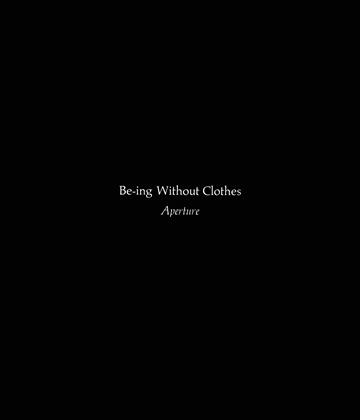The Family
Be-ing Without Clothes excludes no part of humanity. Who does not undress every day, or encounter nudity at birth and death? Be-ing Without Clothes excludes no part of anatomy. Doesn't contemporary hedonism delight in exposing skin to sun and view? And isn't nakedness a weapon of the young often used to express disapproval, disgust, even revolt? If men and women "under thirty" come closest to exhibiting what the theme means, then the kitchen cat is the very embodiment of Be-ing Without Clothes.
Two years ago photographers were asked to turn their cameras to the theme of Be-ing Without Clothes; to "search out the livingness" discovered in the presence of unclothed family, friends and models. One reason for the choice of theme was the shrinking of the photographer's world - policemen, high fences, National Guard, "No Trespassing" signs. The theme was chosen partly because the unclothed human form is in itself a medium of expression and aesthetics; a medium that camera may document in living thought. Also, it was wondered if photographers would recognize the word “be-ing" contained in the common word “being.“ The word is as difficult to define in images as it is in words. Since few recognized it, either in themselves or in their images, the exhibition is only an aerial map of a terrain that exists today, awaiting exploration. In fact, this exploration is now underway by several photographers.
Photographing the human form and flesh raises a few problems not bothersome to the other arts. The bikini tatoos of the suntanned may be the least of the problems, while self-consciousness in front of and behind the camera is the bête noire of the whole encounter. The solutions to the theme sent to the Creative Photography Laboratory at Massachusetts Institute of Technology came in every color, shape and mode: emulation of the classic nude found in painting and sculpture; echoes of the fractured human form introduced by Cubism at the beginning of this century; the classic snapshot confronting us with our own psychological nakedness; work by those who believe with Zarathustra that sex is the bounty of God.
Instead of forcing the entries to fit a preconceived structure, we let all eleven hundred photographs determine the shape of the exhibition and the form of the text. During the preliminary reviews of work submitted for selection, two strong modes or gestalts crystallized: (1) The search for the ideal, including both the affirmation and the denial of the search. (2) The family seeking an honesty of being: warm, organic, and by touch affirming its existence. Following the emergence of these we saw that camerawork, being itself “without clothes,“ rejects nothing - the ugly dance with the beautiful, the nude with the naked, the banal with the ideal. Camera accepts everything within vision and in turn regenerates us by its two inherent powers: the power to record and to metamorphose. How astounding is camera! With its unique ability to register continuous value or tone, camera can sanctify even the ugly and the dead, clarify the ordinary, and, in a moment, turn a hundred-andeighty degrees to play iconoclast. Later work on the exhibition combined with a study of Sir Kenneth Clark's book on the nude defined a potential ideal form for photography relative to its images of the unclothed human figure. Out of the search for be-ingness among the photographs selected, the ideal form typical of camerawork became clear: Be-ing Without Clothes - ultimately neither nude nor naked. Those of us who worked on this exhibition and text, and those who will see the work presented, are grateful for the opportunity to thank more than two hundred photographers for their images, patience and generous cooperation.





















